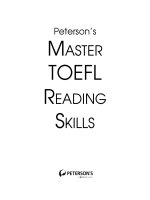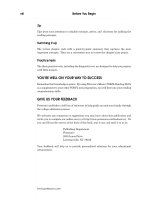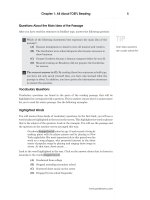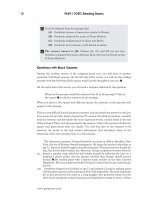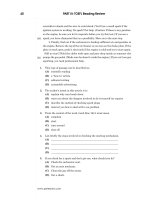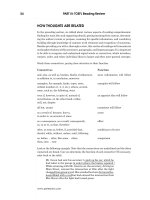Peterson’s master toefl reading skills part 12 docx
Bạn đang xem bản rút gọn của tài liệu. Xem và tải ngay bản đầy đủ của tài liệu tại đây (70.18 KB, 7 trang )
68 PART III: TOEFL Reading Review
www.petersons.com
4. True or false? The public is not concerned with addiction to nonprescription
drugs. _______________
5. Presumably, this selection comes from a
(A) scientific journal
(B) health book
(C) drug company advertisement
(D) psychology textbook
Answers
1. The correct answer is (A).
2. The correct answer is (C).
3. The correct answer is (C).
4. The correct answer is true.
5. The correct answer is (B).
Sample Reading Passage 16
Vitamins are complex compounds that the body requires to function normally.
The word vitamin was coined in the 1990s, but the therapeutic value of certain
foods in combating disease was recognized as early as 3,000 years ago by the
ancient Egyptians. They knew that night blindness could be circumvented by
eating liver, a source of vitamin A. In the 1700s, an Austrian doctor discovered
that eating citrus fruits sufficed to cure scurvy, a disease that affects the blood.
In 1795, the British Navy began to give sailors lime juice to prevent scurvy. The
Japanese Navy learned that too much polished rice in the diet causes beriberi,
a painful nerve disease, and that meat and vegetables, which contain thiamine,
prevent the disease.
In the early 1900s, as the causes of an increasing number of diseases were
identified as vitamin deficiencies, vitamins were labeled with the letters of the
alphabet. Researchers discovered more than twenty-six vitamins, which are now
referred to by both letter and chemical names. For example, the vitamin B
complex includes twelve vitamins.
1. True or false? Vitamin deficiencies first developed in the twentieth century.
_______________
2. If you were planning to cross the ocean in your own boat, what would you
take with you to prevent beriberi? _________________________________
__________________________________________________________________
3. Name a food other than liver that will prevent night blindness because it
contains vitamin A. _______________
4. True or false? Some diseases are caused by vitamin deficiencies.
_______________
(5)
(10)
(15)
03_TOEFL Reading Ch 3,31-91 7/29/06, 12:0068
Chapter 3: Developing Reading Comprehension Skills 69
www.petersons.com
Answers
1. The correct answer is false.
2. The correct answer is meat and vegetables.
3. The correct answer is milk, eggs, butter, vegetables. Answers will vary.
4. The correct answer is true.
Sample Reading Passage 17
Joan is fourteen years old, a bright student, and suffering from self-imposed
starvation. She has anorexia nervosa. Anorexia means “without appetite,” and
nervosa means “of nervous origin.” One morning six months ago Joan looked at herself
in the mirror and decided she needed to lose a few pounds. Then five feet three inches
tall and weighing 110 pounds, she presently weighs 81 pounds and is in the hospital
where she is undergoing psychiatric treatment and being fed intravenously.
What happened to Joan? Why has she ruthlessly starved herself nearly to death?
Joan is a typical anorexic—an adolescent girl who refuses to eat for the purpose
of rebelling against the pressures imposed upon her by the adult environment.
Family members—sometimes the mother, sometimes the father, sometimes
both—require her to achieve more than they have in their lives. In her mind, school
unites with her family to push her forward. Submissive for years, what does she
finally do? She refuses food, says no to the two forces that are pushing her. Instead
of growing into a mature woman, she holds back her physical growth by self-
imposed starvation. In fact, she regresses to childhood, to the stage when she
lacked curves, no one expected much from her, and she was dependent upon adults
who gave her love and approval without demanding anything from her in return.
Anorexia nervosa, formerly not recognized as a disease, has become common
among adolescent girls. Today the cure is prolonged treatment by a psychiatrist
who initiates discussion among family members and the patient to determine the
causes and ways to eliminate them in the future.
1. The main purpose of paragraph 1 is to
(A) define and describe anorexia nervosa
(B) tell what caused Joan’s starvation
(C) give Joan’s past and present weight
(D) suggest a cure for anorexia nervosa
2. The main idea of paragraph 2 is
(A) an anorexic is most likely to be an adolescent
(B) an anorexic is in rebellion against pressures in her environment
(C) Joan regressed to childhood
(D) Joan’s parents wanted her to succeed
3. The main idea of paragraph 3 is
(A) an anorexic can cure herself
(B) the family of an anorexic must agree to see a psychiatrist
(C) the cure of anorexia involves time, discussion, and professional help
(D) anorexia is now considered a disease
(5)
(10)
(15)
(20)
03_TOEFL Reading Ch 3,31-91 7/29/06, 12:0069
70 PART III: TOEFL Reading Review
www.petersons.com
4. List the details in paragraph 2 that support the main idea.
(A) ________________________________________________________
(B) ________________________________________________________
(C) ________________________________________________________
(D) ________________________________________________________
(E) ________________________________________________________
5. Describe Joan before and after she developed anorexia nervosa.
__________________________________________________________________
__________________________________________________________________
6. Anorexia nervosa is currently recognized as a
(A) mystery
(B) cure
(C) disease
(D) regression
7. The cure for anorexia nervosa is
(A) forced feeding
(B) psychiatric treatment
(C) intense discussion
(D) dependence upon the family
Answers
1. The correct answer is (A).
2. The correct answer is (B).
3. The correct answer is (C).
4. (A) Joan refuses to eat to rebel against the pressures imposed upon her
by her environment.
(B) Family members require her to achieve more than they have.
(C) School unites with her family to push her forward.
(D) She holds back her physical growth by self-imposed starvation.
(E) She regresses to childhood when no one expected much from her and
she was dependent upon adults who gave her love without demanding
anything from her in return.
5. Before Joan developed anorexia nervosa, she weighed 110 pounds; now she
weighs 81 pounds and is in the hospital, where she is undergoing psychiatric
treatment and being fed intravenously.
6. The correct answer is (C).
7. The correct answer is (B).
03_TOEFL Reading Ch 3,31-91 7/29/06, 12:0070
Chapter 3: Developing Reading Comprehension Skills 71
www.petersons.com
Sample Reading Passage 18
Fortunately there are still a few tasty things for us gourmands to enjoy in relative
security. Their numbers, however, are depleted almost daily, it seems, by ruthless
proclamations from the ever-vigilant Food and Drug Administration and its allies,
our doctors. The latest felon to face prosecution is the salt of life, sodium chloride.
Ostensibly, overuse of salt causes high blood pressure and hypertension. A few
years ago the antisalt campaigners raised such a rumpus that salt was banned
from baby food. Pressure was being applied to food manufacturers to oblige them
to label their products to show sodium content. Because doing so would cost
manufacturers money, they argued that they had no idea how much salt remains
on such things as potato chips and how much sticks to the bag. Furthermore, salt
isn’t the only harmful ingredient in food. The debate at the time was if the
manufacturer has to provide sodium content, why not require him to list every
ingredient and specify which are detrimental to our health? Cigarettes have a
warning printed on them. Shouldn’t the same type of warning appear on canned
foods that are notoriously oversalted?
There are endless ifs and buts in the controversy, but the most telling of these is
the questionable proof of salt’s diabolic effect upon the blood pressure. True, people
who cut their salt intake lowered their blood pressure, but where is the scientific
proof that something other than salt didn’t do the trick? The most common means
of providing dubious proof that salt causes hypertension is to compare societies
that use little salt with those that use mountains of salt in their daily diets. Which
group has the higher rate of hypertension? Whose blood pressure is lower? What
happens when salt is introduced into a group where salt is a novelty? Does the
blood pressure rise significantly? Studies of Japanese salt-intake indicated that as
the world’s greatest salters, they suffer the most from hypertension. On the other
hand, the simple, salt-free cuisine of several tribes in the Solomon Islands has kept
older members of the tribe from developing hypertension and high blood pressure.
No account is taken of the effects of inflation, recession, pollution, crime, and
sundry other ills to which Americans, unlike people on underdeveloped islands,
are exposed.
To salt or not to salt? That is the question. Now that the question has arisen, it
must not be treated with levity but, rather, with searching scientific investigation
so that those of us who are preoccupied with both savory food and longevity may
decide which of the two is worth its salt.
1. The attitude of the author of this passage toward the salt controversy is
that
(A) we must stop eating salt immediately
(B) she is still not convinced that salt is harmful
(C) the Food and Drug Administration works well with doctors
(D) soon there won’t be anything tasty left to eat
2. The author’s approach to the topic is
(A) angry
(B) humorous
(C) scientific
(D) sympathetic
(5)
(10)
(15)
(20)
(25)
(30)
03_TOEFL Reading Ch 3,31-91 7/29/06, 12:0071
72 PART III: TOEFL Reading Review
www.petersons.com
3. Presumably a gourmand is a
(A) person
(B) theory
(C) food
(D) protest
4. Some food manufacturers did not want to label packages with sodium
content because
(A) they disagree with the FDA
(B) salt doesn’t stick to potato chips
(C) they would have to spend more money
(D) it isn’t important to single out salt
5. True or false? At present baby food contains salt. _______________
6. Canned goods should have the same type of warning as cigarettes because
(A) both contain salt
(B) the author likes to smoke and eat
(C) the cigarette warning reduces smoking
(D) both are harmful to your health
7. True or false? Comparing societies is a scientific means of determining the
dangers of salt consumption. _______________
8. According to the passage, the Japanese use a lot of salt
(A) but they suffer from hypertension
(B) and they suffer from hypertension
(C) because they suffer from hypertension
(D) when they suffer from hypertension
9. True, false, or information not given? People in societies that use little salt
never have high blood pressure. _______________
10. The author suggests that Americans suffer from hypertension as a result of
(A) too much salt
(B) emotional stress
(C) salt-free cuisine
(D) ailments
Answers
1. The correct answer is (B).
2. The correct answer is (B).
3. The correct answer is (A).
03_TOEFL Reading Ch 3,31-91 7/29/06, 12:0072
Chapter 3: Developing Reading Comprehension Skills 73
www.petersons.com
4. The correct answer is (C).
5. The correct answer is false.
6. The correct answer is (D).
7. The correct answer is false.
8. The correct answer is (B).
9. The correct answer is information not given.
10. The correct answer is (B).
Sample Reading Passage 19
Most people are unaware of the fact that an ailment has developed among subway
users. Called “subway syndrome,” it causes people to turn pale and cold and even
to faint. Commuters misdiagnose the symptoms—acute chest pains and nausea—
and rush to hospital emergency rooms in the belief that they are about to succumb
to a heart attack. Hearing that their heart attack is only a case of nerves makes
them feel better.
What makes people get sick on subways? Various and sundry things. One is that
they rush off to work in the morning without having eaten a proper breakfast.
Sudden dizziness attacks them. A second cause is the overcrowding and ensuing
feeling of claustrophobia, which brings on stress and anxiety. In addition, they are
so afraid of mechanical failure, fire, and/or crime that they show signs of panic—
men by having chest pains and women by becoming hysterical. Contributing
especially to their stress are other factors: overcrowding of both sexes, continual
increase in the numbers of passengers, and people’s inability to avoid interacting
with strangers.
Noise, lack of space, summer heat, fear of entrapment underground—it is a wonder
that more people don’t have subway syndrome. What therapeutic measures can a
commuter take to inoculate himself or herself from the disease? Eat a good
breakfast, concentrate on pleasant thoughts as you stand surrounded, bounce a bit
on your toes, and roll your head. Thus, mind and body will be restored to a semblance
of normality despite the adverse conditions of subway transportation.
1. What is the main idea of paragraph 1? Is it stated in a specific sentence or
is it implied? _____________________________________________________
__________________________________________________________________
2. List the supporting details of the main idea in paragraph 1.
(A) _______________________________________________________________
(B) _______________________________________________________________
(C) _______________________________________________________________
3. What is the main idea of paragraph 2? Is it stated or implied?
____________________________________________________________________
____________________________________________________________________
(5)
(10)
(15)
(20)
03_TOEFL Reading Ch 3,31-91 7/29/06, 12:0073
74 PART III: TOEFL Reading Review
www.petersons.com
4. List the supporting details in paragraph 2.
(A) ________________________________________________________
(B) ________________________________________________________
(C) ________________________________________________________
(D) ________________________________________________________
(E) ________________________________________________________
5. What is the main idea of paragraph 3? ______________________________
__________________________________________________________________
6. List the supporting details in paragraph 3.
(A) ________________________________________________________
(B) ________________________________________________________
(C) ________________________________________________________
(D) ________________________________________________________
7. Why do subway riders think they might be having a heart attack?
(A) They are overcrowded.
(B) They are afraid.
(C) They suffer from chest pains.
(D) They don’t eat breakfast.
8. According to the passage, if you don’t have a good breakfast, you might get
(A) cold
(B) pale
(C) afraid
(D) dizzy
9. The author suggests that subway riders will feel better if they
(A) exercise a little
(B) think about pleasant things
(C) eat breakfast
(D) All of the above.
10. A good title for this passage might be
(A) How to Ride the Subway
(B) A Case of Nerves
(C) The Subway Syndrome
(D) Overcrowding on the Subways
03_TOEFL Reading Ch 3,31-91 7/29/06, 12:0074
